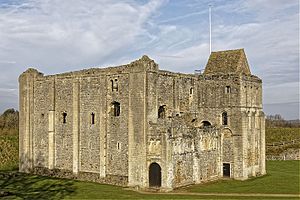Castle Rising (castle)
| Castle Rising | |
|---|---|
| Castle Rising, Norfolk, England | |

Castle Rising's keep, seen from the south-east, with its distinctive pilaster buttresses, and the forebuilding on the right
|
|
| Coordinates | 52°47′34″N 0°28′08″E / 52.7928°N 0.4689°ECoordinates: 52°47′34″N 0°28′08″E / 52.7928°N 0.4689°E |
| Grid reference | grid reference TF66572455 |
| Site information | |
| Owner | Lord Howard of Rising |
| Open to the public |
Yes |
| Condition | Ruins |
| Site history | |
| Built by | William d'Aubigny II |
| Events | Revolt of 1173–1174 |
Castle Rising is a ruined medieval fortification in the village of Castle Rising, Norfolk, England. It was built soon after 1138 by William d'Aubigny II, who had risen through the ranks of the Anglo-Norman nobility to become the Earl of Arundel. With his new wealth, he constructed Castle Rising and its surrounding deer park, a combination of fortress and palatial hunting lodge. It was inherited by William's descendants before passing into the hands of the de Montalt family in 1243. The Montalts later sold the castle to Queen Isabella, who lived there after her fall from power in 1330. Isabella extended the castle buildings and enjoyed a regal lifestyle, entertaining her son, Edward III, on several occasions. After her death, it was granted to Edward, the Black Prince, to form part of the Duchy of Cornwall.
During the 15th century, the castle became increasingly valued for its hunting facilities rather than its military defences. It fell into disrepair and, despite the construction of new living quarters and service facilities, by the middle of the 16th century it was derelict. Henry VIII sold the property to Thomas Howard, the Duke of Norfolk, and most of the castle buildings were demolished. It was not until the 19th century, when Mary and Fulke Greville Howard inherited the property, that the castle was renovated and restored. Victorian scholars examined the site, and it was opened to the public. In 1958 the castle passed into the custody of the state, which carried out further stabilisation work and a programme of archaeological investigation. In 1998 English Heritage passed the management of the site back to its current owner, Baron Howard of Rising, who continues to operate the castle as a tourist attraction.
...
Wikipedia

